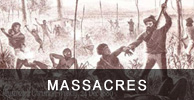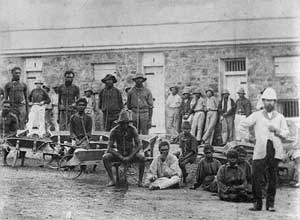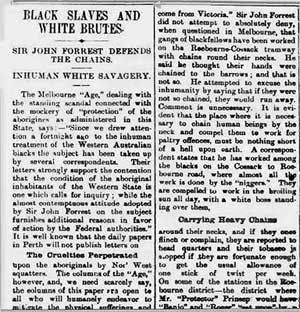First Royal Commission on atrocities against Aboriginal prisoners - WA 1905
Includes full report with pdf download and related image gallery
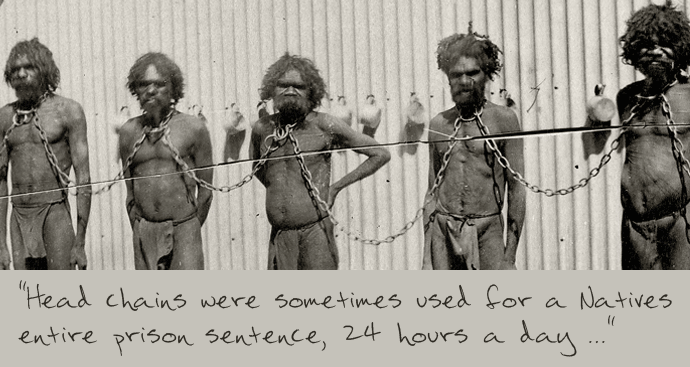
Notice the tin mug placed in strategic places on the tin wall behind the prisoners - if one wanted a drink or go to the toilet the whole gang would have to go with them. In some cases, people were chained next to a member of a tribal group that is culturally inappropriate to even to speak to - never-loan the different customs and language barriers.
Page 5

See enlargement instructions below page 6
Page 6

ENLARGEMENT INSTRUCTIONS
.
Roebourne, Pilbara WA
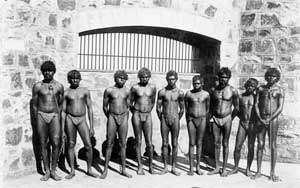
Roebourne Prison inmates

Roebourne Prison
(Photo – Battye Library, WA)

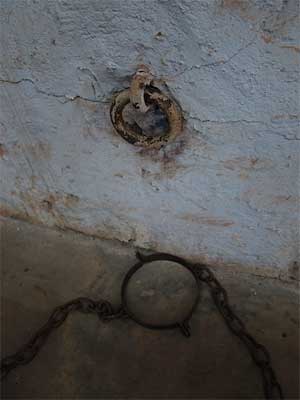
Chain ring in Roebourne prison. The band on the floor goes around the prisoner's neck.
Marble Bar, Pilbara WA
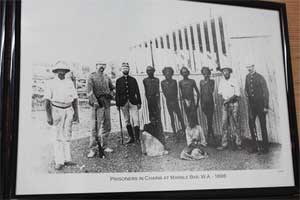
Prisoners in chains at Marble Bar, Pilbara, Western Australia in 1898
Wyndham, East Kimberley WA

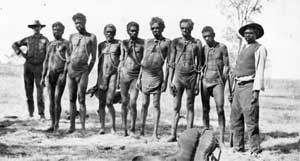
Bringing prisoners to Wyndham for spearing cattle, 1930. (The Battye Library)
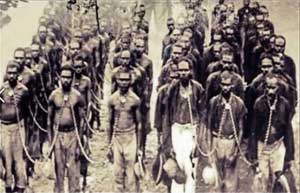
For more images see:
Prisoners of Frontier Wars - Blackbirding & Chain Gangs
THE ABORIGINES QUESTION
*DR ROTHS INVESIGATIONS
TREATMENT OF ABORIGINAL PRISONERS CHARGES AGAINST THE POLICE
The West Australian (Perth, WA)
Tue 31 Jan 1905 Pages 5 and 6
Dealing with the important subject of the treatment of aboriginal prisoners, Dr Roth, in his report to the Government, writes:
Cattle killing is the chief offence for which natives are sentenced in the northern parts of the State; indeed, the proportion it bears to other crimes committed by them is about 90 per cent. It is attributable to settlement in a new part of the country where the aboriginal race is rather numerous in the Kimberley districts, for instance. Objections to European settlement from the natives point of view one which must not be lost sight of-are discussed what dealing with the question of reserves.
In connection with the arrest of aborigines accused of this crime, your Commissioner has received evidence which demonstrates a most brutal and outrageous condition of affairs.
Not the least important of the links in this chain of evidence has been supplied by two native prisoners, who, by a strange concatenation of events, proved to be the very men arrested by constables who had already been called before him as witnesses. The arrest of natives and their subsequent treatment on charges of cattlekilling may be detailed as follows ;
When starting out on such an expedition the constable takes a variable amount of provisions, private and Government horses, and a certain number of chains. Both he and his blacktrackers, as many as five of them, are armed with Winchester rifles. A warrant is taken out in the first place, if information is laid against certain aborigines, but when the police go out on patrol, and the offence is reported, the offenders are tracked and arrested without warrant. Very often there is no proper information laid, in that it is verbal when already out on patrol, there may be no information at all. Blacks may be arrested without instructions, authority or information received from the pastoralist whose cattle are alleged to have been killed; the pastoralist may even object to such measures having been taken.
Not knowing beforehand how many blacks he is going to arrest, the police can only take chains sufficient for about fifteen natives; if a large number are reported guilty, he will take chains to hold from about 'twenty-five to thirty Chains, - in the northern, not in the southern, portion of this State are fixed to the necks instead, of to the wrists of native prisoners. Authority for this is to he found in No. 647 of the police regulations, which states that
Children of from fourteen to sixteen years of age are neck-chained.
There are no regulations as to the size, weight, mode of attachment, or length of chain connecting the necks of any two prisoners. When the prisoner is alone, the chain is attached to his neck and hands, and wound round his body; the weight prevents him running away so easily.
According to the evidence of the Commissioner of Police, when there is more than one aboriginal connected, the attachment of the chain would be to the saddle of the mounted police officer, but only when absolutely necessary; such an accident as a native neck-chained to a bolting horse his not yet happened to his knowledge. The mode of attachment of the chain around the neck is effected with handcuffs and split links; the latter bought privately, i.e., at the expense of the arresting constable from a firm in Perth, and doubtfully with the knowledge of the Police Commissioner. The grave dangers attendant on the use of these iron split-links, and the difficulty of opening them in case of urgency or accident are pointed out. The fact of the connecting chain being too short is also dangerous, because, if a prisoner fell, he would be bound to drag down the prisoner on either side of him; yet the Wyndham gaoler[sic] has noticed the length of the chain joined two natives' necks to be 24in. the cruelty of which he remarked upon to the escorting police.
As far as one witness can find out from police and natives the chains are never taken off when crossing rivers and creeks. In addition the neck-chains the prisoner the prisoners can be further secured on his wrists (as your Commissioner has seen in photographs of constables escorting the chain gangs), or on his ankles. Apparently unknown to the Commissioner of Police, chains are used for female natives not only at night, but sometimes during the day. These women are the UNWILLING WITNESSES ARRESTED ILLEGALLY for the Crown.
The actual arrest usually takes place at daylight in the morning, when the camp is surrounded, and, occasionally the (armed) tracker is sent in by himself first. Accompanying the police may he the manager, or stock men, Who have volunteered to come, but as the manager does not prosecute, and the stockmen are not called as witnesses, this voluntary action on the part of the station employees may admit of another construction, or instance, of the two constables examined, one takes no precautions at night to prevent the assisting stockmen and trackers having sexual connection with the chained-up female witnesses and yet supposes such intercourse to go on.
The other never watches his trackers, who might carry on in this way and never takes any notice of these things--it would have caused trouble if, he did. It is noteworthy that these same two constables, together with two others, are charged by natives with intimacy with the women. The females brought in as witnesses are usually young ones. About six or seven is the largest number of guns in the arresting party. Perhaps such a quantity is accounted for by remembering that as many as 33 prisoners 'have been secured on-the one occasion.
The larger the number of prisoners and witnesses, the better pecuniary for the police, who received from 1s 6½d to 2s 5d daily per head, or, as it is called in the north-western vernacular, "per knob." This expenditure is spread over four departments, as follows:--The Crown L: v pays for the witnesses brought to and from the Court. the gaols[sic] for sentenced prisoners in the police lock-ups, the police for prisoners from the time they are arrested until such time as they are convicted, and the aborigines for prisoners returning to their own country on expiry of their sentence.
One constable admits making a profit, a corporal considers that this allowance acts as a temptation to bring in a larger number of prisoners and witnesses than otherwise, a civilian does not think so many cases would be brought before the courts if these allowances were not sanctioned, a resident magistrate has always been struck with the idea that this was always the reason for so many natives being brought in at a time. etc.
Your Commissioner is satisfied that the amount of purchased food given to natives while on the road in usually constitutes but a fraction of the native food supplied, eg. lizard, kangaroo.
Not withstanding the challenged statement of the Police, meat is not in usually sold but given to the police on these North-Western stations. The daily amounts allowed per head are charged for under the heading of Aboriginal Prisoners' rations Account, and the Treasury paymasters, etc., at Wyndham, Derby, and Hall's Creek have been called upon to supply items.
In less than three years up to date the amount so expended in the North-West districts of the State, north of Broome alone, has been £3,529 16s. 2d., and even this is incomplete, your Commissioner having reason to believe that certain of the claims are paid into private banking accounts, and so need not appear on the local paymaster's list. Examples of the total amounts which certain of these constables, etc., have individually received are as follows:--J. A. Caldow, £259 6s. 9d. since January, 1904; J. Wilson, £462 2s. 7d. between March, 1902, and October, 1903, and £192 14s" 7d. since July 1904, it not having transpired how much he received between October, 1903, and July, 1904: J. Inglis, £29 17s. 1d. in October, 1902, and £165 16s. between April. 1903, and May, 1904; F. W. Richardson, £121 7s. 8d. between October and December, 1903; J. C. Thompson, £300 19s. 1d. between March, 1901, and May, 1904, with £33 9s. 5d. since then; W Goodridge, £138 10s. 8d. since April, 1903; J. O'Brien, £138 5s. 9d. between November, 1901, and August, 1902; A. H. Buckland. £215 12s. 6d. since March, 1903: M. Mulkerin, £335 6s. since November, 1901: J. P. Sullivan, £230 11s. up to September, 1904. One of these recipients alleges that such moneys are paid into the mess fund at the station, so that the profits are indirectly shared by other police officers.
The number of aborigines brought in being the great desideratum, each having a money value to the escorting officer, it is not surprising to find that little boys of immature age have been brought in to give evidence, that children, varying in age between 10 and 16, are charged with killing cattle, that blacks do not realise what they are sentenced for, that an old and feeble native arrives at the end of his journey in a state of collapse and dies eighteen days after admission into gaol[sic]. It is only fair to state, (with regard to the cattle-killing children just referred to, some of whom were found neck chained in the Roebourne gaol[sic]. that, as soon as the attention of the Executive was drawn to them by your Commissioner they were released.)
Besides being half-starved, blacks are "hammered" on the way down. Any detentions on the journey in with the prisoners, or out with the witnesses, are also encouraged by this system of [...] capitation fees.
The Resident Magistrate at Wyndham complains of the constable's delay in bringing down six alleged cattle-killers and the four witnesses, of the corporal and lock-up keeper detaining discharged prisoners, etc., unnecessarily. Because rations are charged for to take the witnesses home again, it does not follow that they are escorted back; in some cases they are certainly not; in others, they may hardly have time to get to their destination before they are "ushered in" again by the police with another mob. It is no secret that the police say, if the ration allowance was cut down or taken away, they would not arrest so many natives. By their own assertions, every native caught means more money in their pockets; reliable witnesses have heard such assertions made. At present there is nothing to prevent the constable arresting as many blacks as he chooses, while there is no limit to the number of witnesses he is allowed to bring in with him. With a view to avowedly justifying their action in bringing these large batches of prisoners into court as many as ten or fourteen at a time the police necessarily take care to make absolutely sure of a conviction, and, unfortunately, the Criminal Code Amendment Act of 1902 is the means of putting a suitable weapon into their hands. By 2 Edw. VII., No. 29, Sec. 5, "If an aboriginal native charged before Justices with any offence not punishable with death pleads guilty the Justices may deal with the charge summarily. But no sentence of imprisonment imposed on summary convlation shall exceed three years."
To secure a conviction the accused are accordingly made to plead guilty - at the muzzle of the rifle, if need be. At this your Commissioner is not at all surprised, considering his firm conviction. In the truth of a statement made him by a native lately released from gaol[sic], where be had served a sentence for cattle-killing, to the effect that one of the batch of prisoners originally arrested with him was shot by the escorting constable in the forehead, the victim in question being very sick at the time. Owing to the informant's lack of proper pronunciation, your Commissioner unfortunately, cannot absolutely identify the murderer's name, though he has reported the matter to the proper authorities.
With regard to the young women witnesses, their prostitution by the escorting police, the trackers, and stockmen, etc., who have aided in hunting them down, has already been referred to: partly for this reason and partly to gain their acquiescence in the subsequent court proceedings, their treatment on the way down, as compared with the men, is tempered with, perhaps, a little more mercy in the way of tucker and comparative freedom. Though these women are allegedly as guilty as the men, one constable states that he is acting under instructions in not arresting them; on the other hand, they are chained or otherwise prevented getting away: they are practically asked to turn informers: they
in the proper sense of the term when giving evidence against their husbands and thus do not, in the slightest degree, realise the harm they may be doing.
The excuse made for bringing in these women at all is that the constable can get no other native evidence, or that "the grown-up men are those that kill the bullock; there are no young boys in the tribes; the squatters have them all. The accused mail prisoners still less understand their position. On their arrest. which may even be before any evidence detrimental to them had been received, they are asked (apparently without being cautioned) whether they have killed a beast, but not necessarily informed with what they are charged; they do not, at the time, thoroughly understand what the charge is, but might, a few hours later, evidently after the gins evidence had been suborned.
The police tracker is the medium of communication, occasionally has to converse through a second interpreter, and camps with the prisoners and witnesses before the case is brought into court. No witnesses are ever brought in for the defence. Furthermore, the pastoralist or station manager does not prosecute: he is generally very busy; it is a matter of domestic economy, he would be only too pleased to prosecute if he could do so with a minimum of personal inconvenience. It is quite intelligible that such an individual's personal convenience should be thus respected; the liability of the accused to a sentence of three years' hard labour, possibly in neck-chains throughout the whole of that period, is hardly worth consideration it is ONLY A "NIGGER."
The Resident Magistrate, Wyndham, states:
Thus, all to the advantage of the Prosecution, when once this native has been induced to plead guilty, there is no necessity under this Criminal Code Amendment Act of 1902 for any awkward questions being asked concerning proof of identity or ownership of the beast, the actual killing. eating. or alleged removal of the carcass. One witness who has brought about, for perhaps over 100 natives into court does not remember any who have been found "not guilty:" under the circumstances already detailed, this is no matter for surprise. In two cases drawn attention to before the Commission where the accused pleaded not guilty, they were of course remanded: to quarter sessions, the charges were thereupon withdrawn on the application of the corporal of the police on account of the expense of maintaining the witnesses. Your Commission recommends the ABOLITION OF NECK-CHAINS, and their substitution by wrist cuffs," one prisoner's right hand being connected by chain to his neighbour left. All the officers in charge of "the three North-Western gaols[sic] admit that by this method the transport of prisoners could be effected in safety. There should also be an alteration in the present system of allowing the police to draw so much "blood-money" for each native prisoner. If rations are purchased At the stations or stores en route they should, be charged for on vouchers.
The Resident Magistrate, Derby rejects to the procedure already mentioned in the Criminal Code Amendment Act, in that he thinks it has resulted in depriving the aboriginal of one of his chances of assistance. His evidence on this and kindred questions is well worthy of perusal. He is now altering the usual procedure, and has told the police that in future he would 'expect the aggrieved party himself - the pastoralist, etc., whose cattle have been killed - to prosecute in person; and 'that' where such cases are of the nature: that: the Criminal Code is amended to cover he will endeavour, on the grounds expense, to hold special sessions for them. He has also objected to the question being put to the native to _ _ _ _ cause why he should not be committed for the particular offence; for by the time it is explained, he usually regards it as an opportunity to admit the crime. The Act of Parliament however, directs that the question be put whether he has killed or not killed; and if a black committed the offence he will plead guilty i.e., admit the offence.: For thins _ _ _son this witness does not think the question should be put, but he is forced to do so when dealing with the case under the Criminal Code Amendment Act.
Of course, the same evidence which convicts an aboriginal with a plea of guilty would convict a European under a similar plea; but the latter intelligent enough not to risk any, unnecessary chances. Blacks are charged; conjointly in these cattle-killing cases as many as 14 at a time. The Resident Magistrate, Wyndham has felt all along that the natives, first of all DO NOT THOROUGHLY UNDERSTAND the charge against them, and that they do not understand the nature of the crime of killing a beast. His fellow magistrate at Derby thinks that the blacks kill the cattle for the mere sport of it, although they may do so for the want of food when the kangaroos (destroyed by the pastoralist on account of sheep and cattle) become sparse, beyond what the Bench can do in the way of justice and fair play to the aboriginal -- and both at Wyndham and Derby your Commissioner is satisfied that the present occupants have done their best under the circumstances - the accused usually has no one specially appointed to act in his defence, on the charge of cattle-killing or of murder. On the other hand, small amounts for this purpose have been expended by the Aboriginal Department. In a case of murder - the depositions are signed and sent to the Attorney-General Perth, who decides whether the indictment should be filed. It has happened that the magistrate holding the preliminary inquiry has been put in the unenviable position' "of acting under this commission as a judge of the Supreme Court. If a native is being tried for his life, the _ _ _ _ the State can do is to give the accused the fullest justice in its power, with a view to directing the jury to the best of its ability. The medical men placed:. in this responsible position, while conscientiously doing what is right. have, however, received no special training in the law. Two Resident Magistrates are dissatisfied with the present system of TRYING SAVAGES FOR TRIBAL MURDERS.
One believes in them managing their own tribal affairs, the other considers there should be special laws and procedure for them. By the same section of the Criminal Code Amendment Act, and by the Justices Act of 1902, section 32, which permits a justice of the peace to adjudicate by himself in the absence of another honorary magistrate within a radius of 10 miles, the terrible power is given to any of these justices of sentencing a native to three years, in addition to a flogging (section 655 of the Criminal Code). Fortunately, the whipping ordered under such circumstances cannot be carried out without the sanction of the Governor-in Council. Not a single witness consulted approves of such a power being given to a Justice.
On looking over the warrants at the various gaols[sic], your Commissioner finds that natives have been sentenced under such circumstances, e.g., four of these warrants were dated May 8, 1903, and signed by D. W. Green, J.P., the postmaster at Turkey Creek. There is nothing to prevent a Justice sitting on a neighbouring Justice's grievance and although he may not be an interested person within the meaning of the Act, he is actually interested in the principles involved. It is thankful to learn from the Broome gaoler[sic] that sentenced for cattle-killing are not quite so long as they have been in former years. On the other hand. the Chief Protector _ _ _ts justification for severe sentences (three years) for this charge, on the grounds that other and more unlawful means might be taken against the native. Surely the Executive would not hesitate to arraign the pastoralist for murder?
A CHILD OF 10 SENTENCED
At Wyndham, when-boys from 14 to 16 have been charged with cattle-killing, the Resident Magistrate has sanctioned, convicted. and released them without imprisonment. At Derby when a young boy comes into Court, the Resident Magistrate prefers give a small sentence and to find him an employer. At Hall's Creek the whole brutality of the present system brought into prominence when the Acting Resident Magistrate sentenced a child of 10 years of age to six months hard labour for "that he did, on or about September 10, 1901, near Cartridge Springs, unlawfully kill and carry away one head of cattle, the property of R. Muggleton(?), contrary to statute then and there provided." The same Magistrate has sentenced another infant of 15 to nine months for killing a goat, and at least eight other children between 14 and 16 years of age to two years' hard labour for alleged cattle-killing. As already mentioned, four of the latter met with by your Commissioner in the Roebourne gaol[sic] have since been released.
Your Commissioner recommends a modification of section 5 of the Criminal Code Amendment Act and invites the Crown Law officers to consider the advisability of allowing the Acting Resident Magistrate at Hall's Creek to continue in office. So far as tribal homicides are concerned, no action should be taken in the courts or otherwise, when the killer has become such a terror or "bully" that his clansmen are afraid to deal with him, or, owing to length of contact with civilisation, he ought to have known better, or the killing has taken place in the neighborhood of close European settlement. Even then unless very particular circumstances demand it - and this would be for the Chief Protector to decide the culprit should be deported and detained in another district, in employment if necessary, under the provisions of section 15 of the proposed Bill.
IN THE GAOLS
Your Commissioner visited the gaols[sic] at Carnarvon, Broome. Roebourne and Wvndham, and is able to place on _ _ _ _ his high appreciation of the h _ _ _ supervision and considerate treatment exercised by the gaolers[sic]over their aboriginal prisoners. Approximately there are about 300 native prisoners in the gaols[sic] throughout the State. Two very degrading and yet remediable features of the prison system are the neck-chains,
and their continuous use morning, noon, and night - usually throughout the entire period of sentence.
Though the Comptroller-General of Prisons has no legal authority for using neck-chains at all, and there are no regulations as to weight, size, and mode of fixation (Yale locks, split-locks, or cuffs, etc.), he has nevertheless given instructions for their employment in the case of natives. His predecessor gave similar instructions. Except in times of sickness, etc., the prisoner is neck-chained from the day he comes into gaol[sic] until the day he leaves it, sometimes from two to three years and upwards, according to sentence. There appears to be differences of opinion as to whether neck-chains should be leather-covered or remain bare. so as to minimise chaffing, etc. At night in the Roebourne gaol[sic] the chains are fastened to rings in the wall, etc.; at Wyndham one _ _ _ _ of every group of three (neck-chain together is chained by the ankle to a ring-bolt on the floor; at Carnarvon the chains connecting one prisoner's neck-chain with another's serve to fix them around the central post supporting the roof. Still neck-chained the native prisoners work outside on the roads, etc.; they thus work about eight hours daily at Broome, seven and a half hours at Carnarvon, under six hours at Roebourne, and somewhat longer at Wyndham. Though the number of hours is fixed by the gaols[sic] regulations, No. 263, slight alterations have to he made here and there in the summer time; at Carnarvon there is the medical officer's standing order that all prisoners are to be brought into gaol[sic] when the thermometer stands _ _ _ or over 98deg. in the shade. On the other hand, at Broome there is no distinction made between winter and summer months; in the gaoler's[sic] opinion, the hours are too long in the latter season, and in some cases the PRISONER'S HEALTH HAS BEEN AFFECTED in the way of sunstroke.
All the gaolers[sic]the North-West are in agreement that the present system of neck-chains should be abolished, and suitably replaced by wrist-cuffs, one prisoner's right hand being connected by chains to the neighbours left: that a shorter connecting chain could be used, that more freedom of movement would be allowed, that the present employment outside the prison walls would not be interfered with, and that when necessary, the transport of prisoners thus chained could be effected in safety. This method of chaining natives does not appear to have been known to the Comptroller-General of Prisons who in correspond with the Aborigines Protection Board expressed the wish to see his way of abolishing chains, but stated that he see no other method of retaining the aboriginal, except within walls. Your Commissioner was certainly surprised to find that such walls, except at Roebourne had not yet been built. Chains could be abolished in the case of aboriginals working inside the prison, and at night, if the gaols[sic] were properly built as temporary measures all that would be required is a cheap iron fence at Broome and Wyndham, and a chevaux-de-frise at Robourne. By 50 Vic: No. 25, see section 33, the Governor-in-Council may place an 'aboriginal prisoner "under custody of any officer or servant of the Government." who is thus responsible and the prisoner is deemed to be in legal custody, wherever he may be employed or detained. Though this has been done within the last 12 months, the Comptroller-General does not consider the system a good one. So far as rules and regulations provided for by the Act for the employment and safe custody of such prisoners are conspicuous by their absence. An aboriginal prisoner is being
LENT OUT TO A RESIDENT MAGISTRATE
on doubtful legal authority. Others on the instructions of such an official are labouring outside the prison walls, on public and municipal works and for local Roads Boards. In return for the work done for the Carnarvon Municipal Council they get a little tobacco, which it is believed, is paid for out of the Mayor's private pocket. Although they may be improving the value of local and municipal property, no payment is received by the Government towards reducing the expense of their keep or return-home journey when liberated, or even of covering the cost of their clothes, which, on expiry of their sentence, the Aborigines Department has to provide. Furthermore, the gaols[sic] Department regulations Nos. 264 and 266 preclude any gratuity being given on re!ease to an aboriginal - another colour distinction - although he may be as civilised and appreciate the value of money as well as his European fellow captive.
LONG SENTENCES
With regard to long sentences passed upon native prisoners, they are not considered' beneficial. The blacks are far better in their uncivilised than semi-civilised state and are a great deal of trouble after they come out of gaol[sic]. It does not do them the least bit of good, and does not stop then from killing cattle, the same blacks being brought before the Court again and again. Your Commissioner has also been informed that, according to the prison dietary, their taste for beef is still further cultivated. When blacks have been away from their native Homes so long they seem forgotten when they return: their tribes will have very little to do with them and they often commit further crimes because in the meantime their women have seen taken. It is doubtful whether the aboriginal prisoner understands his position or knows that he is committing an offence when he tries to break gaol[sic]. One gaoler[sic] is of opinion that among the 20 blacks in his charge sentenced for cattle-killing not one really understands what he is there for.
Another, with 72 prisoners, thinks that about one-third of them know. Another states that when he took charge a great number of the prisoners were "myalls," and their idea was that they were there for road-making but that, as they became educated and get to gaol[sic] so often they now realise that it is for cattle-killing.
In the Kimberley district due care does not seem to have been always taken as to the identity of prisoners when first brought to gaol[s].
CARELESSNESS ALMOST AMOUNTING TO CRIMINALITY.
is responsible for longer sentences having been exchanged for shorter ones, and for one case where a prisoner having two native names has really received two sentences on the same charge, while a fellow-prisoner's name was on no warrant at all. When once in gaol[sic]. however, due precautions are taken in the way of attaching numbered metal pegs to the chains.
The transfer of prisoners from one gaol[sic] to another is carried out under the escort of the police and not of the warders who know their prisoners and understand their temperaments better. Alone at Wyndham there would appear to be a valid reason - delay in the return of the warder why this work should not be always undertaken by the officers of 'the gaols[sic] Department.
Certainly on two occasions, owing to running short of handcuffs. two batches of prisoners 20 in each batch, were received at Roebourne bearing neck-chains fixed with split-locks. evidence was taken on the difficulty in unloosening such fastenings and the terrible risks run on board the steamer conveying them. In spite of police regulation No. 647, it would appear that during transport on the "steamer the neck-chains are not removed.
FLOGGING OF NATIVES
is not approved by the gaolers[sic]at Broome and at Roebourne: at Wyndham the officer in charge approves of it in certain cases, say, for assault on a warder, although such has never occurred. The Resident Magistrate at Marble Bar does not think whipping as cruel as imprisonment, than which it has a more deterrent effect: he would have ordered it oftener only for public opinion being so much against it. The flogging of natives is referred to the comptroller-general of prisons for approval before being carried out : a merciful provision.
RECOMMENDATIONS
Your Commissioner recommends the bolition of chains of all description within the precincts of the gaols[sic], the insecure condition of which should be remedied without delay. In English prisons, e.g., Portland, chains are used only in punishment "for the most serious offences-assaults on officers, attempts at escape, and persistent insubordination or refusal to work; the irons consist of rings for the ankles and two chains. which are linked together and fastened to a belt: their weight varies from six to ten pounds, and when a prisoner is put into them he wears them constantly day and night for the period of his punishment, for which the maximum is six months."
In the North Western gaols[sic] of Western Australia chains are used on natives only because of the inadequate or faulty construction of the buildings: the irons consist of a chain round each prisoner's neck connected with other chains by cuff, etc.. to his neighbours' necks; the weight of the neck-chain, cuff, and connecting chain is as much as 5¼ pounds, but as the centre man has to carry the weight of the chains connecting the individuals at his side, he, of course, bears most of the strain, and double that carried by the others; he wears it constantly, often as long as three years, and sometimes more, according to the length of sentences. With chevaux-de-frise around the central courtyard at Roebourne, and with a properly constructed galvanized iron fence around the boundaries of the prison grounds at Broome and Wyndham, the use of chains could be safely prohibited. The fence recommended by the gaolers[sic]would he from 12ft. to 14ft. high, of corrugated iron, with supporting battens on the outside, and nothing in the way of barbed wire on top. When called upon to work outside the prison walls, your Commissioner recommends the abolition of neck-chains, and their substitution by:
- Wrist-cuffs and connecting chains, as approved of by all three officers in charge of the North Western gaols[sic], who state that the present employment of natives outside the prison walls would not be interfered with.
- Waist-belts and connecting chains; or
- Anklets joined by chain when the prisoners are required to work singly.
In the last-mentioned proposal the ankles of each prisoner are connected by a light chain up to 20 or 22 inches long, an arrangement which allows him to walk but not to run, and at the same time gives full scope to the free movement of his arms and trunk. When working for municipal or local bodies these corporations should be made to pay for the prisoners' rations, etc., while so employed, and also for the clothes supplied to them when liberated, the latter charge at present falling upon the Aborigines Department. The hours of outside labour in these tropical climates should certainly be limited to six, as at Roebourne, and even then curtailed when the temperature is greater than 98 deg. in the shade, as is already insisted upon, according to the medical officer's orders at Carnarvon. Wherever, practicable, prisoners, when transferred, should be escorted by warders and not by constables. Furthermore, gaolers[sic]should not be allowed, as at present, to receive instructions from the Resident Magistrates. but only from the sheriff and comptroller-general of prisons.
Transcribed by SU Volunteers
Apologies for possible errors and/or omissions - use the newspaper clippings enlargements for verification
Includes full report with pdf download and related image gallery
Related material:
Every Mother's Son is Guilty: Policing the Kimberley Frontier of Western Australia 1882-1905 - Link to Book Sales




